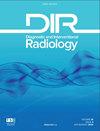Evaluation of lung volume loss with 3D CT volumetry in COVID-19 patients.
IF 1.7
4区 医学
Q2 Medicine
引用次数: 4
Abstract
The standard test for the assessment of coronavirus disease 2019 (COVID-19) is the reverse-transcription polymerase chain reaction (RT-PCR) testing. Chest computed tomography (CT) is recommended for severe cases as a complementary diagnostic tool for staging COVID-19 pneumonia in progressive disease or if any complication is suspected during the follow-up (1, 2). Most common CT findings of COVID-19 pneumonia include multifocal and bilateral ground-glass opacities (GGOs) and/or consolidation in the peripheral, posterior, and lower lobes of the lungs. Halo or reverse halo sign, vascular enlargement, crazy-paving pattern, pleural thickenings, pleural effusion, and subpleural lines are less common CT findings (3, 4). In most cases, the disease and CT findings are mild and moderate and heal completely, but severe cases may develop acute respiratory distress syndrome or pulmonary fibrosis, and lung volume loss (5–7). In particular, lung volume is determined by the elastic forces of the lung parenchyma and surrounding tissues, alveolar surface tension, respiratory muscle strength, lung reflexes, and airway structure (8). The etiology of lung volume loss can be listed as follows: airway obstruction or compression, obesity, scoliosis, restrictive diseases such as pulmonary fibrosis and interstitial lung disease, tuberculosis, sarcoidosis, pleural effusions, rib injury (fractures or diaphragm paralysis), and heart failure, among others (9). The volume loss findings in COVID-19 cases have begun to emerge with the recent literature data. Notably, consolidated and/or collapsed parts of the lungs lead to a reduction in lung volume, which is considered to be one of the pneumonic presentations of COVID-19 (10). In our opinion, the loss of volume in patients with COVID-19 may be explained as follows: a) destruction of type II epithelial cells by the virus resulting in a decrease of surfactant that keeps alveoli open; b) as part of the immune response, the blood vessels around the air sacs leak in response to the inflammatory chemicals released by white blood cells, and this fluid exerts pressure on the alveoli from the outside causing them to collapse; c) occurrence of microvascular thrombi, which have been detected as one of the lung autopsy findings in patients with COVID-19 (11). Inflammatory microthrombosis causes vasoconstriction in alveolar capillaries. While ventilation is normal in this region, perfusion deteriorates (ventilation/perfusion (V/Q) mismatch) and increases dead space ventilation. Consequently, reduced compliance causes alveolar collapse (11, 12). The etiology of the volume loss due to COVID-19 pneumonia, its clinical correlation, and its value in the prognosis need further evaluation. We show an example of volume loss by analysis of lung volumes with follow-up CT scans in a patient with severe clinical findings in Figs. 1 and 2. We suggest that CT measurement of volume loss may provide objective data for both progression and long-term follow-up in COVID-19 patients. Three-dimensional (3D) CT lung volumetry method on the postprocessing workstation gives an estimate of the total lung volume using the CT density thresholds with mathematical algorithms that are available at the workstation. Although it is a very practical method, the most important limitation of 3D CT volumetry is that the volume of the scanned lung varies according to the amount of air inhaled before the scan, therefore, it is directly linked to the inspiratory capacity of the individual. However, patients may be provided with breathing training before the CT examination to minimize the variation (13). In our experience, it is possible to calculate 3D volume with standard or low-dose CT scan, but it is recommended to use the same breathing instruction protocols for the follow-up scans in order to achieve a high precession. Another important point for minimizing the lung volumetric errors is the choice of slice thickness of the CT scan protocol, which should be performed with 1 mm or thinner sections and spiral volume scanning. In conclusion, we suggest that diseases that cause volume loss, including pulmonary fibrosis, which may develop in the follow-up of COVID-19, can be easily detected with 3D CT volumetry.3D CT容积法评价COVID-19患者肺容量损失
本文章由计算机程序翻译,如有差异,请以英文原文为准。
求助全文
约1分钟内获得全文
求助全文
来源期刊
CiteScore
3.50
自引率
4.80%
发文量
69
审稿时长
6-12 weeks
期刊介绍:
Diagnostic and Interventional Radiology (Diagn Interv Radiol) is the open access, online-only official publication of Turkish Society of Radiology. It is published bimonthly and the journal’s publication language is English.
The journal is a medium for original articles, reviews, pictorial essays, technical notes related to all fields of diagnostic and interventional radiology.

 求助内容:
求助内容: 应助结果提醒方式:
应助结果提醒方式:


